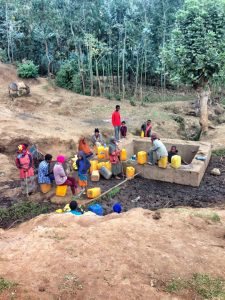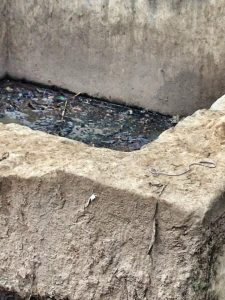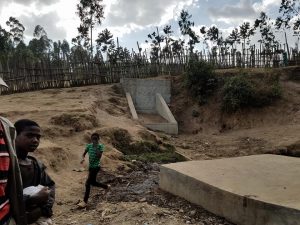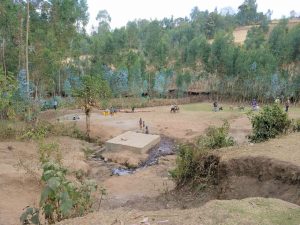This project, to rebuild the Lamore spring so as to provide water for Doyogena, is made possible through the partnership of WATER CHARITY and the NATIONAL PEACE CORPS ASSOCIATION. ![]()
This project has been completed. To read about the conclusion, scroll down below.
Location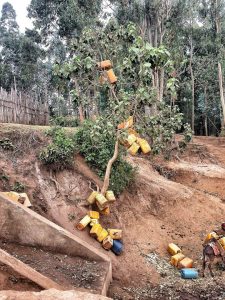
Lamore Spring in the Doyogena Woreda, Kambatta-Tambaro Zone, Ethiopia
Doyogena is a beautiful welcoming community. It is a highland area surrounded by scenic mountains and greenery. The local plant, known as an inset, and also known as false banana, can be seen in abundance through the land and along the roads.
Doyogena is the woreda center town of the Doyogena Woreda. Doyogena has 17 kebeles, 13 rural and 4 urban. This woreda is fairly recent, only being established as its own woreda about 7 years ago. Doyogena is located in the Kambaata-Tambaro region, and the local language spoken is Kambatina.
Lamore Spring is found approximately 1 km from the Doyogena town center, and 170 km from the regional capital, Hawassa. Lamore is a natural spring, the water source coming from the ground. In 1986 a small reservoir was constructed to store the natural spring water, and allow it to be distributed to the community. At that time, it was estimated to serve more than 700 people.
Due to the small size, unenclosed reservoir, and giant hole, the water is contaminated and unclean. The community members often wait overnight in order to fill their “jerry cans” with the slow dripping water from the pipe connected to the natural spring. The discharge of the spring has been getting higher, and the collection chamber is not able to reserve enough water to satisfy the increasing demand of society. The community also faces a shortage of the main water supply in the town. There is no money for them to budget for the much-needed repairs. The leaky pipes, broken enclosure, and contamination of this water source are a source of consternation for all the people of the region
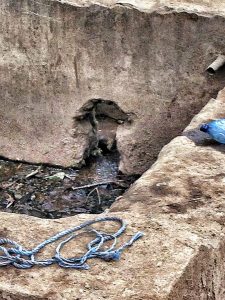 .Project Description
.Project Description
The proposed solution for the Lamore spring rehabilitation is to build a new reservoir, holding container for the natural spring water. The reservoir will have a capacity of 10,000 liters and will behave a concrete foundation. There will be 4 faucets out of one outlet so that 4 different people can access it at one time. It will be fully enclosed to ensure that the water stays clean and avoids contamination from rainwater/ other natural elements. The new reservoir will be built in an open area of land next to the natural spring and will be connected by a pipe to the current pipeline.
The project includes:
-Cleaning the capping box area
-Rehabilitating the existing collection chamber
-Constructing the existing water point
-Making a drainage line to take the spilled water
-Constructing a protective fence around the water point
Much of the planning on the project was done by Melody Halzel, Returned Peace Corps Volunteer.
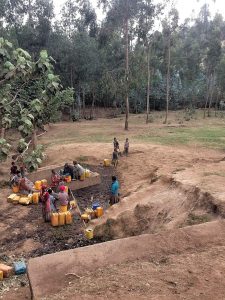
By restoring the Lamore spring, and creating a new reservoir to hold the water, the community (over 2,000 in population) will greatly benefit.
Helen Boxwill, Executive Director of H2 Empower
Conclusion of Lamore Spring Rehabilitation Project – Ethiopia
The project was designed to build a reservoir.
Helen reports:
Project Objectives
The objective of the project has been to carry out a rehabilitation work on Lamore Spring located in Doyogena town of Zeraro kebele in SNNPR about 260km south of Addis Ababa and to improve access to safe and clean drinking water for the community in Doyogena town and its surroundings and improve their health condition.Scope of the Project
The project focused on carrying out a comprehensive rehabilitation work of the spring with masonry work and protect the spring making sure that water wastage from the spring is avoided and increase the amount of water from the spring and improve the quality of the water to make it safe to drink for the community in the area.Project Management
The project from starting to completion was monitored and managed by Molla Tadesse with discussion and support from W/Amanuel Abiyo.Project Activities
The main activities carried out during the implementation of the project were to conduct a survey on the exact condition of the spring cooperation with local government and with participation of representatives of the community.
After agreeing and deciding on the type of the work, a contract agreement was signed between Molla Tadesse ,W/Amanuel Abiyo and the representatives of the community and a quality contractor/engineer to carry out the rehabilitation work on the spring and make sure that the work on the spring was long lasting. The necessary suitable materials for the work were purchased with close supervision by those who managed and monitored the project.
The site was cleared through by the contractor before the rehabilitation work on the spring was commenced. The work was completed within 24 days. A retaining wall was built to keep the land from sliding down the hill. Pipes run under the ground from this wall to a water storage container which will be monitored by the water department and was twice as big as expected. There is a cover where they can stop the water flow and go inside the container and clean it out or fix any part. Water department can test and administer chemicals if necessary there. Then pipes flow to an area where people can line up the jerry cans in 2 rows and then collect the water.
The storage container will be refilled every day by the water from the spring. There will be a fence and a guard to keep the spring controlled and the water clean. The people are contributing regularly to have funds for maintenance of the project administered by the kebele.
There were some challenges /problems encountered during the implementation of the rehabilitation work of the spring, but after while we made agreement with woreda administration bodies on the budget system then, the budget was managed effectively/economically by those who monitored the project and all the objectives planned in the project have been met and it is possible to confirm that the project has been successfully implemented. The project was practically implemented with the help of the Kebele leaders, community providing labor, the woreda and water department, local engineers and contractor, Molla Tadesse coordinating all in Doyegena, Wolde/ Abiyo coordinating, planning and organization.
Project Outcome
The outcome achieved through the implementation of the Lamore Spring Rehabilitation project is of great importance to the community in the area and the results are measurable.
Through the implementation of the spring rehabilitation project the water was being wasted because the spring was unprotected. Now there no wastage and there is more water from the spring being saved (increased water capacity from the spring and the quality of the spring water improved, the number of the people in the community that have access to clean and safe drinking water has increased).
With the implementation of the spring`s rehabilitation project, people are able to get water from separate points and the risk of getting waterborne disease has greatly decreased, because of the implementation of the spring rehabilitation project and many people are able to benefit from the rehabilitation spring.
Comments From The community And Local Governments
The community expressed that the rehabilitation of Lamore Spring has really helped Doyogena town and its surroundings. There were huge problems they were facing in providing enough water to the community. The community and the local governments thanked the people who supported the project financially, Water Charity.Also, they thanked Helen Boxwill for her encouragement and follow up /coordinating the project. They also thanked Woldeamanual Abiyo, Country Director of h2 Empower, who coordinated the project locally, gave advise and support on all the steps of the project.
Additionally they thanked Melody Halzel because in her stay at Doyogena (in Ethiopia) in her part initially she made good connection to Helen Boxwill, H2 Empower for the success and wrote the proposals. The community representatives in their part told that they are very thankful to Water Charity who kindly gave financial support to implement the rehabilitation project of Lamore spring which has helped them to get clean and safe drinking water for the community.
The administration further expressed its hope that more support will be given to the woreda in the future to be able to meet water needs of the people in the woreda and Thanked the people who supported the project financially!!, Thanks!! From Molla Tadesse, Doyogena, Ethiopia To Helen Boxwill U SA America
We extend our thanks to Helen for completing this important project.
